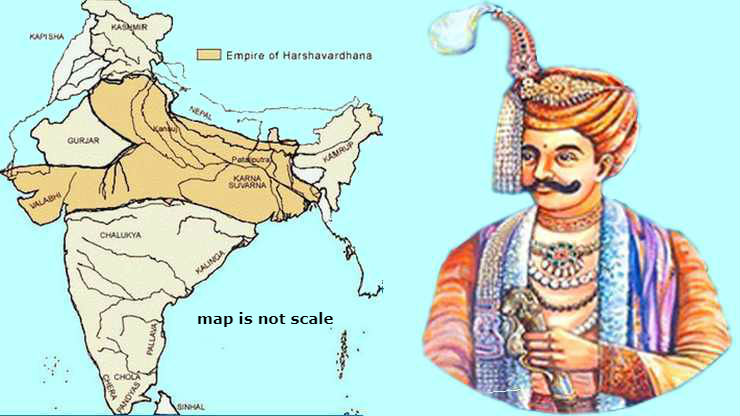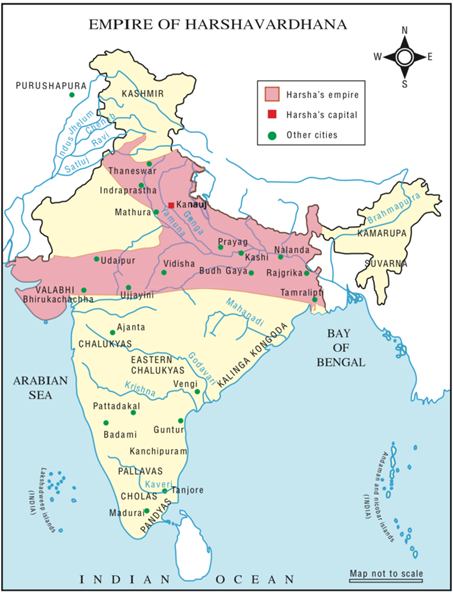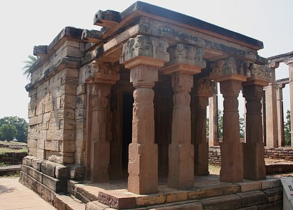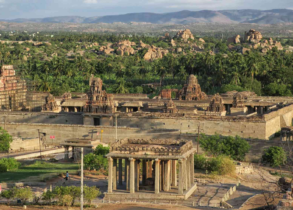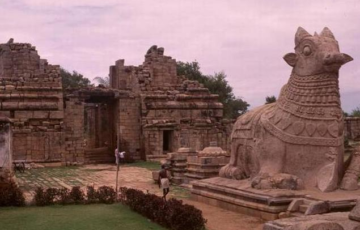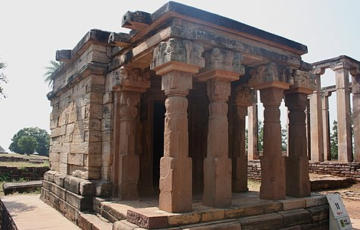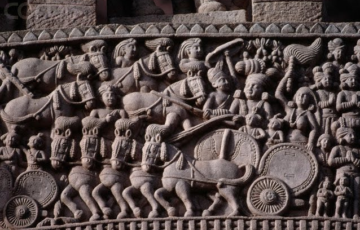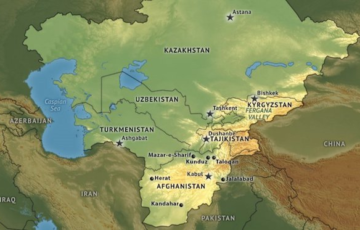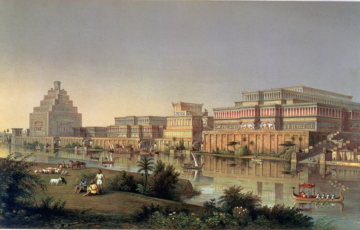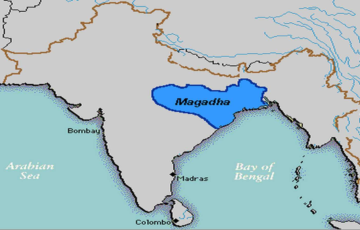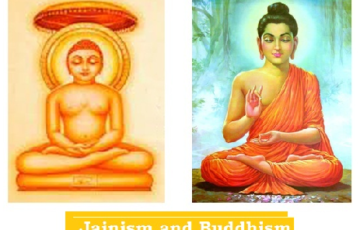HARSHAVARDHANA
Introduction
After the decline of the Gupta Empire, North India fragmented into various kingdoms including – Maithriyas, with their capital at Valabhi in Gujarat, Maukharis, ruling over Agra and Oudh states and Vakatakas in the western Deccan.
- The Pushyabhutis established an independent state at Thaneswar, north of Delhi between the Sutlej and Yamuna rivers, founding the Vardhan dynasty.
- Initially serving a military role under the Gupta Empire, the Vardhan dynasty ascended to authority following the Gupta’s decline.
| Prabhakara Vardhana (580–605 AD) | He expanded his influence by fighting Gurjaras and Huns, extending his reach to Malwa and Gujarat.
● He strategically strengthened his position by marrying his daughter, Rajyasri, to Grahavarman, the Maukhari king of Kanauj. |
| Rajavardhana (605-606 AD) | ● He succeeded his father Prabhakaravardhana but was treacherously murdered by Sasanka, the Gauda ruler of Bengal.
Following Rajavardhana’s death, his younger brother Harshavardhana assumed the throne. |
Epigraphical Sources to study Pushyabhuti
- Madhuban copper plate inscription
- Sonpat inscription on copper seal
- Banskhera copper plate inscription
- Nalanda inscription on clay seals
HARSHAVARDHANA (606-647 AD)
- He consolidated his empire by conquering and integrating neighboring kingdoms.
- He was regarded as the last great Hindu ruler of Northern India.
- The magnates of Kanauj (the capital of the Maukhari kingdom) invited Harsha to become their king, which he accepted on the advice of Avalokitesvara Bodhisattva, taking the title of Rajputra and Siladitya.
- Under his rule, the kingdoms of Thaneswar and Kanauj were united, prompting Harsha to transfer his capital to Kanauj.
Military conquests
- Harshavardhana killed Deva Gupta of Malwa, who sought to marry his sister Rajyasri.
- He issued ultimatums to various regional rulers, including
- Sasanka of Gauda in Bengal
- Maitrakas of Valabhi
- Gurjara rulers of the Broach region,
- Pulikesin II of the Chalukya dynasty
- Rulers of Sindh, Nepal, Kashmir, Magadha, Odra (northern Odisha), and Kongoda (a geographical unit in ancient Odisha).
- Harsha allied with Kamarupa (Assam) to confront Sasanka of Gauda and subsequently subjugated the Gauda Empire after Sasanka’s death.
- Harsha’s attempts to expand southward into the Deccan were thwarted by Chalukya king Pulikesin II, who celebrated his victory by taking the title “Parameswara,” as confirmed by Aihole inscription in his capital, Badami.
- Hostilities between Harsha and the Maitrakas ended with the marriage of Dhruvabhatta to Harsha’s daughter, making Valabhi a subordinate ally of Harsha.
Extent of Harsha’s Empire
- Claims suggest that Harsha’s Empire included Assam, Bengal, Bihar, Kanauj, Malwa, Odisha, Punjab, Kashmir, Nepal, and Sindh.
- However, his actual authority was limited to a compact territory between the Ganges and Yamuna rivers.
- Harsha’s Relations with China:
- Harsha fostered friendly relations with China and lived during the reign of the T’ang emperor, Tai Tsung.
- Emperor Tai Tsung dispatched embassies to Harsha’s court in 643 AD and again in 647 AD.
- After Harsha’s Death: The kingdom of Harsha fragmented rapidly into small states following his demise.
ADMINISTRATION
- Harsha’s administration mirrored that of the Guptas, albeit with a shift towards greater feudalism and decentralization.
- The Emperor was supported by a council of ministers known as the Mantri Parishad. Key officials are –
- Avanti: Minister for Foreign Relations and War
- Skandagupta: Chief Commandant of Elephant Force
- Simhananda: Commander-in-Chief
- Dirghadhvajas: Royal Messengers
- Kuntala: Chief Cavalry Officer
- Mahaprathihara: Chief of the Palace Guard
- Banu: Keeper of Records
- Sarvagata: Secret Service Department
Revenue Administration
- According to accounts by Hiuen Tsang, traders were required to pay duties at ferries and barrier stations.
- Three types of taxes were collected:
- Bhaga, a land tax in kind amounting to one-sixth of the produce.
- Hiranya, a cash tax levied on farmers and merchants.
- Bali, which is not well-documented.
- Land grants to officials began during Harsha’s reign, with crown land and revenue divided into four parts:
- Part I was allocated for state affairs.
- Part II was designated for paying ministers and crown officers.
- Part III was reserved for rewarding scholars and men of letters.
- Part IV was dedicated to charity for religious institutions.
Judicial Administration during Harsha’s reign
- Harsha’s era introduced stricter criminal laws compared to the Gupta period, with punishments including banishment, limb cutting, trial by ordeal, and life imprisonment, particularly for violations of the laws and plotting against the king.
- Mimamsakas were appointed to administer justice.
- Observations of Hieun Tsang
- Despite instances of robbery, law and order appeared well-maintained due to robust law enforcement.
- Corporal punishment was a principal penalty for serious offenses, although its use was minimized due to the influence of Buddhism.
- Maiming served as punishment for offenses against social morality and defiance of the law.
Administrative Divisions: [Bhuktis – Vishayas – Pathakas]
- The empire was organized into multiple provinces, with each province further divided into Bhuktis.
- Each Bhukti was subdivided into several Vishayas, and each Vishaya was further divided into Pathakas.
- Harsha Charita mentions officials such as Bhogapathi, Ayuktha, Pratpalaka-purusha, overseeing local administration.
Cities and Towns
- According to Hieun Tsang, India was characterized by numerous villages, towns, and major cities, with Kanauj emerging as prominent while Pataliputra declined.
- Harsha also instituted charitable initiatives such as free hospitals, aid for the sick and poor, and rest houses (Dharamshala) for travelers.
| Reasons for the Decline of Pataliputra and Rise of Kanauj
● Pataliputra’s decline and Kanauj’s rise were attributed to factors such as a decline in trade, commerce, and the use of coins during Harsha’s reign. ● Power shifted to military camps like Skandhavaras and strategically important locations. ○ Kanauj’s elevated location rendered it strategically significant, facilitating easy fortification. ○ Positioned in the middle of the doab, Kanauj enabled rulers to assert control over both the eastern and western wings of the doab. |
Army Organization
- Hieun Tsang provides details about Harsha’s army, which was divided into four divisions (chaturanga).
- The army included
- Chatas and Bhatas as ordinary soldiers,
- Brihadisvaras as cavalry officers, and
- Baladhikritas and Mahabaladhikritas as infantry officers.
Religious Policy
- Initially a worshiper of Shiva, Harsha embraced Buddhism under the influence of his sister Rajyasri, subscribing to the Mahayana school of thought.
- Harsha convened two Buddhist assemblies
- The Kanauj assembly was attended by 20 kings, including Bhaskaravarman of Kamarupa, along with numerous Buddhist, Jain, and Vedic scholars.
- A golden statue of Buddha was consecrated during the Kanauj assembly.
- The Prayag assembly was known as the Mahamoksha Parishad held quinquennially i.e. every five years, situated at the confluence of the Ganges and Yamuna rivers.
- During these gatherings, he generously bestowed lavish gifts upon Buddhist monks in attendance.
- According to Hieun Tsang, Buddhism’s principles deeply influenced Hindu society, fostering social harmony among followers of different faiths.
- Harsha treated Vedic scholars and Buddhist monks equally, providing equal charities.
- Restrictions were placed on the slaughter of animals and the consumption of meat.
- The Kanauj assembly was attended by 20 kings, including Bhaskaravarman of Kamarupa, along with numerous Buddhist, Jain, and Vedic scholars.
Caste System
According to Hieun Tsang, observed that the traditional four divisions of society remained intact during his time.
- Brahmins and Kshatriyas maintained a modest lifestyle, while nobles and priests enjoyed luxurious living standards.
- Agriculturalists were categorized as Shudras within the societal hierarchy.
- Untouchables, such as scavengers and executioners, resided outside the villages and were required to announce their presence by shouting upon entering town.
- Butchers, fishermen, dancers, and sweepers were relegated to living outside the city limits.
- The caste system exhibited rigid structure, with minimal social conflict among its various segments.
- People were noted for their honesty and generally avoided deceitful or treacherous behavior.
Status of Women
- Women typically adhered to the purdah system, though exceptions were observed among women of higher social status. For instance, Rajyasri did not observe purdah.
- The practice of Sati, where a widow immolated herself upon her husband’s death, persisted during this period.
- An example is Yasomatidevi, the wife of Prabhakara Vardhana, who committed Sati following her husband’s demise.
Dietary Habits
According to Hieun Tsang
- Indians were mostly vegetarians.
- Onion and garlic were rarely used in food preparation.
- Common food items included sugar, milk, ghee, and rice.
- Consumption of beef and meat from certain animals was forbidden.
Education
- Education primarily occurred in monasteries and was religious in nature.
- The Vedas were orally taught, not written down.
- Sanskrit was the language of the learned.
- Wandering bhikshus and sadhus were renowned for their wisdom and culture.
Harsha’s Contribution to Literature
- Harsha patronized literature and culture, with prominent authors like Bana, known for “Harshacharita” and “Kadambari,” serving as his court poet.
- “Harshacharita” was the first formal biography of a king.
- Harsha himself was a notable writer, penning Sanskrit plays like “Priyadarsika,” “Rathnavali,” and “Nagananda.”
- He generously supported education and promoted learning centers like temples and monasteries.
- Renowned scholars taught at monasteries in Kanauj, Gaya, Jalandhar, Manipur, and other places, with Nalanda University reaching its zenith during Harsha’s reign.
Nalanda University
- Documented by Hieun Tsang, Nalanda attracted scholars from China, Japan, Mongolia, Tibet, and Central/Southeast Asia.
- Esteemed teachers/scholars at Nalanda included Dharmapala, Chandrapala, Shilabhadra, Bhadrihari, Jayasena, Devakara, and Matanga.
- In 670 AD, the Chinese pilgrim I-Tsing visited Nalanda.
- The monastery at Nalanda was financially supported by the revenue of 200 villages.
| Hieun Tsang (630-643 AD)
● He was a Buddhist monk from China who journeyed to India during Harsha’s reign. ● His travelogue is known as ‘Si-Yu-ki’ (Buddhist Records of the Western World). ● He earned the moniker “prince of pilgrims” for his extensive visits to significant Buddhist pilgrimage sites. ● He spent approximately five years studying at the University of Nalanda. ● Harsha esteemed him for his devoutness to Buddha and his extensive knowledge of Buddhism. ● During his travels, Hieun Tsang carried relics of Buddha, Buddha images, and manuscripts. |
UPSC PREVIOUS YEAR QUESTIONS
1. The Chinese traveller Yuan Chwang (Hiuen Tsang) who visited India recorded the general conditions and culture of India at that time. In this context, which of the following statements is/are correct? (UPSC CSE 2013)
1. The roads and river-routes were completely immune from robbery
2. As regards punishment for offences, ordeals by fire, water and poison were the instruments for determining the innocence or guilt of a person
3. The tradesmen had to pay duties at ferries and barrier stations.
Select the correct answer using the codes given below.
a) 1 only
b) 2 and 3 only
c) 1 and 3 only
d) 1, 2 and 3
2. Which of the following phrases defines the nature of the ‘Hundi’ generally referred to in the sources of the post-Harsha period? [UPSC CSE 2020]
1. An advisory issued by the king to his subordinates
2. A diary to be maintained for daily accounts
3. A bill of exchange
4. An order from the feudal lord to his subordinates
| IMPORTANT FACTS RELATED TO THE CHAPTER
● Detailed information about Emperor Harsha is available from the “Harshacharita,” written by Banabhatta, who served as Harsha’s court poet. ● Additional details can be found in the “Rajatarangini” written by Kalhana. However, there is no mention of Harsha in the works of Kalidasa and Harisena. ● Harsha convened a grand council of various religions and sects in Kannauj to establish the superiority of Mahayana Buddhism over other religions. ● Chinese records indicate that rulers from 20 countries, along with their eminent Brahmins, Shramanas, and courtiers, attended the council, which was presided over by Hiuen Tsang. Additionally, every fifth year of Harsha’s rule, a significant event known as the “Mahamoksha council” was held at the Sangam region of Prayaga, attended by 18 rulers from various countries. Hiuen Tsang himself attended the sixth such event. ● Emperor Harsha’s southern expansion was halted at the Narmada River by Pulakeshin II, a Chalukyan ruler who defeated Harsha. ● Banabhatta, the poet, was born in the village of Prithikuta, situated on the banks of the Son River in Aurangabad district (present-day Bihar). His parents were named Chitrabhanu and Rajdevi. ● In post-Harsha period sources, the Hundi was regarded as a “bill of exchange.” According to the RBI, Hundis were financial instruments developed on the Indian subcontinent for trade and credit transactions. ● Hiuen Tsang, a contemporary of Taai-Sunga, defied Taai-Sunga’s ban on foreign travel to the West and arrived in India via the Silk Route in 629 AD. Thirteen years after his migration, when he returned to China, the emperor warmly welcomed him and appointed him as his spiritual advisor. At the emperor’s request, Hiuen Tsang recorded his experiences in “A Record of the Western Regions.” |

